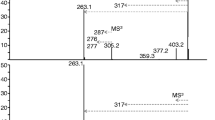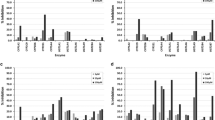Summary
There exists clinical evidence that coupling of chloramphenicol with glucuronic acid is impaired in severe liver disease. To evaluate the theoretical basis of these observations the affinity of UDP-glucuronyl transferase to chloramphenicol was estimated in comparison with other substrates of the enzyme by determining the Michaelis-Menten constants.
The initial velocities of the glucuronyl transferase reactions were used to establish the Michaelis-Menten constants with the aid of Lineweaver-Burk plots. TheK m values were: p-nitrophenol 5.9 × 10−4 M, bilirubin 1.5 × 10−4 M, chloramphenicol 4.5 × 10−4 M, estradiol 2.0 × 10−4 M and UDP-glucuronic acid 1.8 × 10−3 M. Chloramphenicol acted as a competitive substrate on the glucuronidation of p-nitrophenol and estradiol.
Concluding from theK m values the affinity of chloramphenicol to UDP-glucuronyl transferase is only moderately smaller than that of natural substrates of the enzyme.
Zusammenfassung
Bei schweren Leberkrankheiten ist der Spiegel des nicht an Glucuronsäure gekoppelten Chloramphenicols bei Gabe durchschnittlicher Dosen erhöht. Um zu prüfen, ob die Affinität von UDP-Glucuronyltransferase zu Chloramphenicol so hoch ist, daß es mit den natürlichen Substraten des Enzyms in Konkurrenz treten und sich bei einer Verminderung der Enzymaktivität im Serum in ungekoppelter Form anhäufen kann, wurden die Michaelis-Menten-Konstanten für die folgenden Substrate bestimmt: p-Nitrophenol, Bilirubin, Oestradiol, UDP-Glucuronsäure und Chloramphenicol.
Die Anfangsgeschwindigkeiten der Glucuronidierungsreaktionen wurden für die Bestimmung der Michaelis-Menten-Konstanten mit Hilfe von Lineweaver-Burk-Diagrammen eingesetzt. DieK m -Werte der einzelnen Substrate waren: p-Nitrophenol 5,9 × 10−4 M, Bilirubin 1,5 × 10−4 M, Chloramphenicol 4,5 × 10−4 M, Oestradiol 2,0 × 10−4 M und UDP-Glucuronsäure 1,8 × 10−3 M. Chloramphenicol wirkte als kompetitives Substrat bei der Verwendung von Substratgemischen.
DieK m -Werte zeigen, daß die Affinität von UDP-Glucuronyltransferase zu Chloramphenicol nur unwesentlich geringer ist als zu natürlichen Substraten des Enzyms.
Similar content being viewed by others
References
Best, W. R.: Chloramphenicol-associated blood dyscrasias. J. Amer. med. Ass.201, 181–188 (1967)
Beutler, E.: Drug induced anemia. Fed. Proc.31, 141–146 (1972)
Brown, R. B., Grodsky, G. M., Carbone, J. V.: Intracellullar distribution of tritiated bilirubin during hepatic uptake and excretion. Amer. J. Physiol.207, 1237–1241 (1964)
Glazko, A. J., Wolf, L. M., Dill, W. A., Bratton, C. C.: Biochemical studies on chloramphenicol (chloromycetin). Tissue distribution and excretion studies. J. Pharmacol. exp. Ther.96, 445–459 (1949)
Halac, E., Reff, A.: Studies on bilirubin UDP-glucuronyltransferase. Biochim. biophys. Acta (Amst.)139, 328–343 (1967)
Jardetzky, O.: Studies on the mechanism of action of chloramphenicol. I. Conformation of chloramphenicol in solution. J. biol. Chem.238, 2498–2508 (1963)
Kunin, C. M., Glazko, A. J., Finland, M.: Persistence of antibiotics in blood of patients with acute renal failure. II. Chloramphenicol and its metabolic products in the blood of patients with severe renal disease or hepatic cirrhosis. J. clin. Invest.38, 1498–1508 (1959)
Lucier, G. W., McDaniel, O. S., Matthews, H. B.: Microsomal rat liver UDP-glucuronyltransferase: Effects of piperonyl butoxide and other factors on enzyme activity. Arch. Biochem. Biophys.145, 520–530 (1971)
Lueders, K. K., Kuff, E. L.: Spontaneous and detergent activation of glucuronyltransferase in vitro. Arch. Biochem. Biophys.120, 198–203 (1967)
Martelo, O. J., Manyan, D. R., Smith, U. S.: Chloramphenicol and bone marrow mitochondria. J. Lab. clin. Med.74, 927–940 (1969)
Mowat, A. P., Arias, I. M.: Partial purification of hepatic UDP-glucuronyltransferase. Studies of some of its properties. Biochim. biophys. Acta (Amst.)212, 65–78 (1970)
Rao, G. S., Rao, M. L., Breuer, H.: Partial purification and kinetics of 16-glucuronyltransferase from the cytosol of human liver. Biochem. J.118, 625–634 (1970)
Suhrland, L. G., Weisberger, A. S.: Chloramphenicol toxicity in liver and renal disease. Arch. intern. Med.112, 747–754 (1963)
Van Roy, F. P., Heirwegh, K. P. M.: Determination of bilirubin glucuronide and assy of glucuronyltransferase with bilirubin as acceptor Biochem. J.107, 507–518 (1968)
Vazques, D., Monro, R. E.: Effects of some inhibitors of protein synthesis on the binding of aminoacyl-t-RNA to ribosomal subunits. Biochim. biophys. Acta (Amst.)142, 155–173 (1967)
Weichselbaum, T. E.: Accurate and rapid method for determination of proteins in small amounts of blood, serum and plasma. Amer. J. clin. Path.10, 40–49 (1946)
Weisberger, A.: Mechanism of action of chloramphenicol. J. Amer. med. Ass.209, 97–103 (1969)
Author information
Authors and Affiliations
Rights and permissions
About this article
Cite this article
Linhart, P. Affinity of UDP-glucuronyl-transferase for several substrates and for chloramphenicol. Res. Exp. Med. 163, 241–249 (1974). https://doi.org/10.1007/BF01851671
Received:
Issue Date:
DOI: https://doi.org/10.1007/BF01851671




